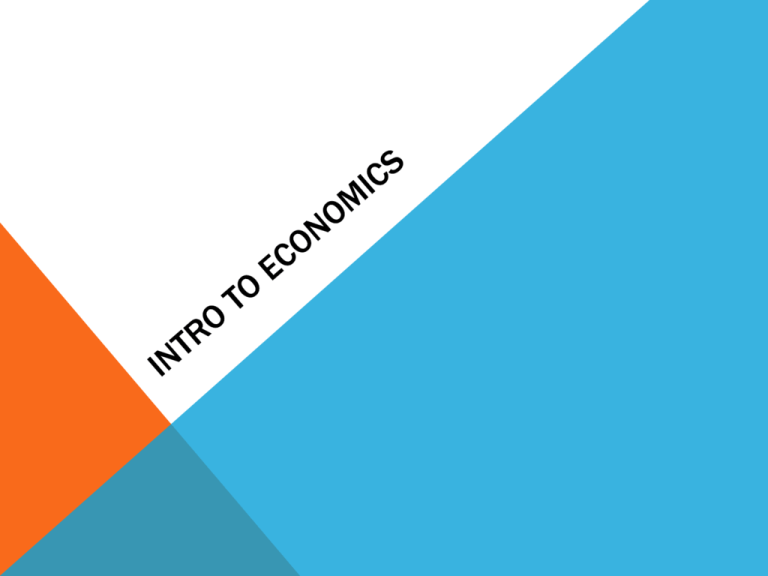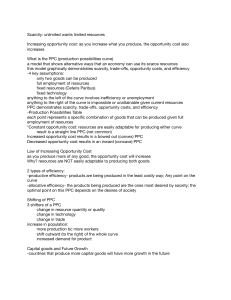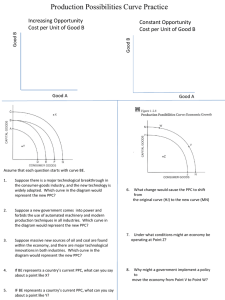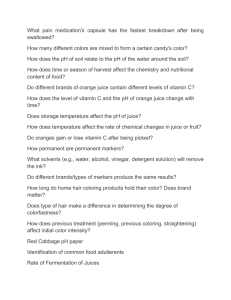Intro to Economics - Ms. McManamy's Class
advertisement

ECONOMIC SYSTEMS • Capitalism: No government regulation or control. Everything it based on private ownership • Socialism: A mixture – some government control, some private ownership. Government usually responsible for welfare of citizens • Communism: Governments controls and regulates everything. No private ownership • Private ownership – owned by individuals • Public ownership – owned by government ECONOMIC SYSTEMS Characteristic Free Enterprise Socialism Communism Property rights Individual Collective Government Incentives Profit Economic freedom Total Limited None Competition Lots Little None Role of the government Little or none Varies Total ECONOMIC PHILOSOPHERS • You will be put into groups • Each group will receive the list of basic characteristics of economic systems • Each group will also be given information on Friedrich Havek, Milton Friedman, John Maynard Keynes, and Adam Smith • Define your basic characteristics and explain the impact each philosopher had on the US free enterprise system • One paper per group, make sure everyone’s names are on it BENEFITS AND POLICY • You will get in groups of 3 • You will receive a list of benefits of the US free enterprise system and a description of each as well as examples of changes in economic policy • Research current economic policies and decide which characteristics are being affected and how • You will present your finings to the class ASSIGNMENT • Your group from yesterday has been given the opportunity to advice the current administration about possible changes to their economic policies. • Topics to consider: • High rate of unemployment • Government regulation vs. government deregulation • Energy efficiency • Discuss, research and develop a recommendation to improve the economy based on one of these topics • You will present your proposal to the class SCARCITY • What do you want to do after you graduate? Make a list of everything you will need to accomplish this goal • Circle any items you DO NOT HAVE right now. • What do you think scarcity means? What in your life is scarce? VOCABULARY TO KNOW (AND WRITE DOWN) • Scarcity – the condition of unlimited wants and limited resources which cause people to not be able to have all of the good and services they desire . • Choice – deciding between opportunities, which results in opportunity cost decisions • Opportunity cost – the next best alternative use of resources SCARCITY ACTIVITY • With a partner read through each statement and decide if there is a scarcity or not. Mark “S” if it is scarce and “NS” if it is not scarce. It is due in 15 minutes THE BASIC ECONOMIC PROBLEM Our resources are limited, yet our wants and needs are unlimited. A society has to choose how best to provide for the needs of its people. BASIC ECONOMIC QUESTIONS What to produce? – This is a production choice. What are you going to make with scarce resources? How to produce? – This is a resource choice. How much of each resource will be used? Will it be labor intensive because you have abundant, cheap labor, or will it be capital intensive because you have abundant technology and capital goods? For whom to produce? – This is an allocation choice. Who gets the products after they are produced? How is this decided, by the government or in the marketplace? FACTORS OF PRODUCTION Land – all natural resources Labor – any human effort, physical or mental, that goes into producing goods and services Capital – man-made goods used in the production of goods and services, sometimes called capital goods (e.g., sewing machine used to make jeans); also the money used to purchase resources needed to produce goods and services Entrepreneurship – person in a free enterprise or capitalistic economy that creatively combines the other three factors to create a new, or different product BASIC ECONOMIC PROBLEMS GRAPHIC ORGANIZER Follow along with me as we discuss the basic economic problems everyone faces Words/Phrases used: People have unlimited needs and wants Scarcity Resources are limited Choices Land What to produce Labor How to produce Capital For whom to produce Physical Human Entrepreneurship OPPORTUNITY COST AND CHOICES You will one of three different charts to practice opportunity cost, scarcity, an choices. Complete and with a partner. Due by the end of the period. PRODUCTIONS POSSIBILITY CURVE • Production Possibilities Curve (or PPC): It shows the possible combination of goods or types of goods that could be produced in an economy. • A Production Possibilities Curve demonstrates the concept of “opportunity cost”. • Resources are limited. And to take on a new activity would require using some of the resources used in the original activity. • This is assuming that all resources (land, labor, and capital) are being used to their fullest potential and no more resources exist. This concept is called efficiency. • If all resources are not being used efficiently, the country is experiencing “underutilization” of resources more commonly known as a recession ROBINSON CRUSOE PPC • We’ll assume that Crusoe and Friday had access to a market for coconut milk and pineapple juice on a sparsely inhabited nearby island. They are totally efficient in production if they are operating anywhere on the production possibilities curve. If they produce inside the curve they are underutilizing their resources. • On the “y axis” of the graph (left side), the possible quantities for production of coconut juice are provided. On the “x axis” (bottom) the possible quantities for pineapple juice are provided. The table at the bottom of the page shows some possible combinations of the two goods that could be made efficiently. ROBINSON CRUSOE PPC • Place a point on the curve where 25 quarts of coconut milk are being produced and label it “A”. • At this point, how many gallons of pineapple juice are being provided? • Place a point on the curve where 20 gallons of pineapple juice are being produced. Label it point “B.” • How many quarts of coconut milk are being produced at point “B”? • What was the opportunity cost in terms of coconut milk production when pineapple juice production was increased from 10 gallons to 20 gallons? • Now place a point on the graph where 15 quarts of coconut milk and 10 gallons of pineapple juice are being produced. Label it “C”. Did this point reach the curve? • You can see that by drawing a diagonal line from point “C” over to the curve, that Crusoe and Friday are short in production by five gallons of pineapple juice and five quarts of coconut milk in their current underutilization of available resources. ROBINSON CRUSOE PPC • The economy of a nation sometimes can increase the amount of resources available. It may find new mineral resources (land), have an in-migration of talented workers (labor), improve its banking system (capital), or acquire new territory (land). In this situation, that nation has greater production possibilities. This is represented on the Production Possibility Graph as a shift to the right in the PPC. Now, to attain efficiency, it must effectively utilize those new resources. • • Conversely, the nation’s economy could deplete or lose some of its resources. In such a case, the PPC shifts to the left. Efficiency is attained according to the new production possibilities.





